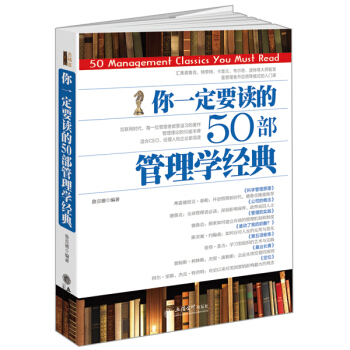![数学与金融经典教材(影印版)·激励理论:委托代理模型 [The Theory of Incentives:The Principal-Agent Model]](https://pic.qciss.net/11154485/rBEHaFDrgB4IAAAAAAWtl34WLl8AADjLAPNAsIABa2v016.jpg)

具体描述
内容简介
The book allows for two levels of reading. Certain sections in some chapters are marked with a star to the right of the section head. A first reading should concentrate on the non-starred sections. These sections are accessible to readers who have a simple knowledge of maximization with inequality constraints. Most essential economic lessons can be understood from this first level of reading. Cov-ering the starred sections will enable smdents to manipulate the concepts for better assimilation and will put them in contact with the advanced topics of the field.内页插图
目录
ForewordIntroduction
1 Incentives in Economic'Thought
1.1 Adam Smith and Incentive Contracts in Agriculture
1.2 Chester Barnard and Incentives in Management
1.3 Hume, Wicksell, Croves: The Free-Rider Problem
1.4 Borda, Bowen, Vickrey: Incentives in Voting
1.5 L60n Walras and the Regulation of Natural Monopolies
1.6 Knight, Arrow, Pauly: Incentives in Insurance
1.7 Sidgwick, Vickrey, Mirrlees: Redistribution and Incentives
1.8 Dupuit, Edgeworth, Pigou: Price Discrimination
1.9 Incentives in Plaiined Economies
1.10 Leonid Hurwicz and Mechanism Design
1.11 Auctions
2 The Rent Extraction-Efficiency Trade-Off
2.1 The Basic Model
2.2 The Complete Information Optimal Contract
2.3 Incentive Feasible Menu of Contracts
2.4 Information Rents
2.5 The Optunization Program of the PrincipaJ
2.6 The Rent Extraction-Efficiency Trade-Off
2.7 The Theory of the Firm Under Asymmetric Information
2.8 Asymmetric Information and Marginal Cost Pricing
2.9 The Revelation Principle
2.10 A More General Utility Function for the Agent
2.11 Ex Ante versus Ex Post Participation Constraints
2.12 Commitment
2.13 Stochastic Mechanisms
2.14 Informative Signals to Improve Contracting
2.15 Contract Theory at Work
Appendix
3 Incentive and Participation Constraints with Adverse Selection
3.1 More than Two Types
3.2 Multidimensional Asymmetric Information
3.3 Type-Dependent Participation Constraint and
Countervailing Incentives
3.4 Random Participation Constraint
3.5 Limited Liability
3.6 Audit Mechanisms and Costly State Verification
3.7 Redistributive Concerns and the Efficiency-Equity Trade-off
Appendices
4 Moral Hazard: The Basic Trade-Offs
4.1 The Model
4.2 Risk Neutrality and First-Best Implementation
……
5 Incentive and Participation Constraints with Moral Hazard
6 Nonverifiability
7 Mixed Models
8 Dynamics under Full Commitment
9 Limits and Extensions
Re ferences
Author Index
Subject Index
前言/序言
The development of the theory of incentives has been a major advance iii eco- nomics in the last thirty years. The objective of this book is to provide easy access to this theory for undergraduate and first-year graduate smdents in economics. Our goal is not to be as complete as possible in covering and surveying the many contributions that have fiourished in the realm of incentive theory. Instead, our contribution is methodological and intended to offer students some iiiitial clues for analyzing the issues raised by this theory. As much as possible we have favored the simplest models to explain the core of the theory. The exposition has been divided into three books for methodological clarity. This volume presents the basic principal-agent theory with complete contracts. It allows a first exposition of the transaction costs created by contracting under asymmetric information without having to appeal to sophisticated game theory concepts.The book allows for two levels of reading. Certain sections in some chapters are marked with a star to the right of the section head. A first reading should concentrate on the non-starred sections. These sections are accessible to readers who have a simple knowledge of maximization with inequality constraints. Most essential economic lessons can be understood from this first level of reading. Cov-ering the starred sections will enable smdents to manipulate the concepts for better assimilation and will put them in contact with the advanced topics of the field.
Going through the text and.checking the proofs should provide a good way for stu-dents to appropriate the material. Throughout the book we have listed under the heading the major references that are useful to pursue the study of incentive theory.
……
用户评价
这本书的封面设计给我留下了深刻的第一印象。简约而富有质感的米白色纸张,搭配深邃的蓝色字体,散发出一种沉静而专业的学术气息。书名“数学与金融经典教材(影印版)”几个字,仿佛预示着这是一部凝聚了学术智慧的结晶,而“激励理论:委托代理模型”更是精准地勾勒出了本书的核心内容,让人充满期待。影印版的处理方式,让我能够窥见到原版书籍的质感,纸张的细微纹理、印刷的墨迹深浅,都仿佛带着一丝历史的温度。翻开扉页,陌生的语言和排版虽然一开始会带来一些阅读上的挑战,但正是这种原汁原味的呈现,才更能体现学术研究的严谨性和国际视野。我并非金融领域的科班出身,但对经济学和行为学中激励机制的讨论一直充满浓厚兴趣。在日常生活中,无论是工作中如何激励团队,还是在家庭中如何引导孩子,都需要对“激励”有深入的理解。这本书的出现,正是我渴望系统性地学习激励理论,尤其是其在金融领域的应用的一个绝佳机会。我期待它能够为我提供一套扎实的理论框架,让我能够将抽象的理论与实际的经济现象联系起来,从而更好地理解市场运作的内在逻辑。
评分这本书的书名,特别是“激励理论”和“委托代理模型”几个字,一下子就抓住了我。我一直认为,经济活动中的许多现象,都可以归结为激励机制的内在逻辑。在金融领域,这种机制更是复杂且至关重要。我尤其好奇,这本书将如何运用数学的语言去描述和分析这些抽象的概念。例如,信息不对称是如何产生的?为什么会形成委托代理关系?如何通过设计合理的契约来解决信息不对称和激励不相容的问题?我希望这本书能够提供严谨的数学模型,帮助我理解这些问题的本质,并且能够看到这些模型在实际金融市场中的应用。我期待通过阅读这本书,能够对公司金融、投资银行、风险管理等领域有更深入的理解,特别是能够洞察到这些领域中隐藏的激励机制对市场参与者行为的影响。我也希望能够学习到如何运用这些理论工具来分析和解决现实中的金融问题,从而提升自己的专业能力。
评分作为一名对量化金融和经济学模型有着强烈探索欲望的读者,我一直在寻找一本能够深入浅出地讲解激励理论核心思想的书籍。这本《激励理论:委托代理模型》的出现,无疑填补了我知识体系中的一个重要空白。我对于“委托代理模型”这个概念本身就非常着迷,它所揭示的人与人之间在信息不对称和利益驱动下的行为模式,在很多经济场景下都显得尤为真实。我希望这本书能够不仅仅停留在理论模型的介绍,更能通过具体的案例分析,将抽象的数学公式转化为生动的经济学故事。例如,在公司治理中,如何设计股权激励来协调股东和管理者的利益?在金融监管中,如何通过引入信息披露和审计机制来减少道德风险?这些都是我非常感兴趣的问题。我期待本书能够提供扎实的数学基础,帮助我理解模型的推导过程,但更重要的是,它能够清晰地阐述这些模型所揭示的经济学洞见,以及这些洞见在现实金融世界中的实际应用。我希望这本书能够成为我理解金融市场微观结构和行为的重要工具。
评分我一直认为,学习任何一门学科,尤其是像金融这样与现实经济活动紧密相连的领域,都不能仅仅停留在表面现象的描述,而必须深入探究其背后的原理和模型。这本书的标题——“激励理论:委托代理模型”,立刻吸引了我。委托代理模型(Principal-Agent Model)在经济学中是一个非常重要的概念,它解释了当一方(代理人)代表另一方(委托人)行事时,由于信息不对称和利益冲突可能产生的各种问题。在金融领域,这种模型更是无处不在,例如股东与管理者之间,债权人与债务人之间,甚至保险公司与被保险人之间,都存在委托代理关系。我非常好奇这本书将如何运用数学工具来构建和分析这些复杂的委托代理关系,尤其是它会探讨哪些具体的激励机制,例如最优契约设计、风险分担、信息披露等。我期待它能够提供清晰的数学推导和严谨的逻辑分析,帮助我理解这些模型是如何运作的,以及它们在现实金融市场中是如何应用的。我希望通过阅读这本书,能够对金融市场的效率、风险以及监管等问题有更深刻的认识,并能够形成自己独立的思考和判断。
评分一直以来,我对经济学和金融学中那些能够解释复杂现象的“模型”非常着迷。而“激励理论”和“委托代理模型”正是我一直想要深入了解的领域。《激励理论:委托代理模型》这个书名,非常直观地指出了本书的核心内容。我渴望了解,当一方(委托人)委托另一方(代理人)去执行某项任务时,由于信息不对称和利益冲突,会产生哪些问题,以及如何通过设计激励机制来解决这些问题。在金融领域,这种委托代理关系更是普遍存在,例如股东与管理者、银行与借款人等等。我希望这本书能够以严谨的数学方法为基础,清晰地阐述委托代理模型的核心思想,并展示如何运用这些模型来分析金融市场中的各种现象,比如高管薪酬的设计、金融监管的有效性、以及公司治理的结构等。我期待通过阅读此书,能够获得一套分析金融问题的理论框架,从而更深刻地理解金融市场的运行机制,并对未来的金融实践有更清晰的认识。
评分从90年代初起,拉丰教授开始关注组织中的激励问题,他深刻认识到了组织中的串谋行为对激励机制造成的扭曲是导致经济组织效率低下的一个最为根本的原因,因此在设计一个经济组织的激励机制时,必须考虑防范串谋的激励机制.a拉丰教授在这一领域作出了开创性的贡献,并将这些理论贡献集成在《激励与政治经济学》(1999年)一书中.
评分好!
评分经典教材,值得仔细阅读,写论文要用,所以就买了
评分没的说,但是就目前水平来说也就是一天几页的速度,加上量化的应用会更考验英文阅读能力
评分编辑本段定义
评分委托代理理论的主要观点认为:委托代理关系是随着生产力大发展和规模化大生产的出现而产生的。其原因一方面是生产力发展使得分工进一步细化,权利的所有者由于知识、能力和精力的原因不能行使所有的权利了;另一方面专业化分工产生了一大批具有专业知识的代理人,他们有精力、有能力代理行使好被委托的权利。但在委托代理的关系当中,由于委托人与代理人的效用函数不一样,委托人追求的是自己的财富更大,而代理人追求自己的工资津贴收入、奢侈消费和闲暇时间最大化,这必然导致两者的利益冲突。在没有有效的制度安排下代理人的行为很可能最终损害委托人的利益。而世界——不管是经济领域还是社会领域——都普遍存在委托代理关系。
评分经典著作,值得购买,性价比高
评分1975年,拉丰教授放弃了在美国一流大学任教的机会,毅然回到法国开始了他艰难的振兴法国经济学的历程.由于在巴黎法国理工学院推行经济学改革遭遇的阻力太大,他只身回到家乡图卢兹,在图卢兹大学任教并传播主流经济学,同时不懈地开创经济学的新领域.经过十几年孤独而又艰苦的创业,1990年,法国产业经济研究所(IDEI)宣布成立,拉丰教授任IDEI主任.在他的爱国热情的感召下,包括让·梯若尔在内的一批在国际上享有盛誉的法国经济学家都来到使它的学术水平和教育质量获得了空前的提高.如今的IDEI已经成为经济学界公认的世界第一的产业经济学研究中心.拉丰教授传播经济学的热情并不局限在法国,他尤其关注发展中国家发展过程中制度变革所带来的激励问题.a他认为发展中国家制度变革的选择最终决定了该国的发展道路,而要顺利地完成一个合理、有效的制度变迁,必须要有一批真正的经济学家参与这一过程.为此,他不遗余力地为发展中国家培养年轻的经济学者,并要求他们学成后回国积极投身经济制度改革.同时他不辞辛劳地到中国、拉美、非洲等地讲学,传播经济学思想,并积极参与发展中国家产业规制政策的实证研究.拉丰教授传播经济学思想的热情和对经济学理论所作的巨大贡献使他赢得了极高的国际声誉.
评分书写的不错,内容很全面
相关图书
本站所有内容均为互联网搜索引擎提供的公开搜索信息,本站不存储任何数据与内容,任何内容与数据均与本站无关,如有需要请联系相关搜索引擎包括但不限于百度,google,bing,sogou 等
© 2026 book.teaonline.club All Rights Reserved. 图书大百科 版权所有




![社会化客户体验:用社交媒体吸引和留住客户 [Social Customer Experience:Engage and Retain Custo] pdf epub mobi 电子书 下载](https://pic.qciss.net/11673923/55248469N1303290e.jpg)








![卖创意:体验经济时代,如何将每一个“灵感小火花”转化为超级生意 [One Little Spark!: Mickey's Ten Commandments] pdf epub mobi 电子书 下载](https://pic.qciss.net/11968414/5768ea9fNde3e4c7f.jpg)






![向3M学创新 [Discovering The Way Of 3M Innovation] pdf epub mobi 电子书 下载](https://pic.qciss.net/12111428/5878905aN8fd14050.jpg)